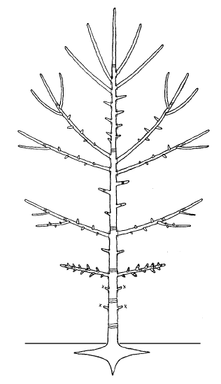Preliminary Course
Botany. Architectural Analysis
An Example.
Wild Cherry Tree (adult)
-
Architectural Analysis of the Wild cherry (Prunus avium L. Rosaceae), cont.
Adult tree
In all mature wild cherry trees four different categories of axes may be recognised.
-
The main stem is an orthotropic monopodial axis with indefinite and rhythmic growth;
its branching pattern is rhythmic.
Branches are horizontal or slanted with long-term definite and rhythmic growth and monopodial and rhythmic branching.
Branchlets present a horizontal growth direction, have medium-term definite and rhythmic growth and bear only brachyblasts.
Brachyblasts are very short axes producing a single cluster of leaves each year; they do not have a precise growth direction, they experience short-term determinate growth (5 to 7 years) and remain unbranched.
Wild Cherry Tree Architectural Unit
This precise organisation concerning the kind and relative position of morphologically discernible categories of axes corresponds to the expression of the specific functional elementary architecture, the architectural unit (table 1 and fig. 4).
| Main stem | Branches | Branchlets | Brachyblasts | |
| Growth | Indeterminate | Long term determinate | Medium term determinate | Short term determinate |
| Growth direction | Vertical | Horizontal to slanted | Horizontal growth direction | No precise growth direction |
| Flowering | First leaves of GU bear inflorescence | First leaves of GU bear inflorescence | First leaves of GU bear inflorescence | All leaves of GU bear inflorescence |
| GU size | 8 to 50 leaves | 8 to 30 leaves | 10 leaves | 3 to 7 leaves | Branching | Bears 4 to 6 long shoots | Bear 2 to 4 long shoots | no | no |
Table 1. The Architecture Unit table of Prunus avium. GU stands for Growth Unit
The table summarises the morphological traits of all axis categories.

Figure 4. The Architecture Unit diagram of Prunus avium.
( Y. Caraglio, CIRAD)
